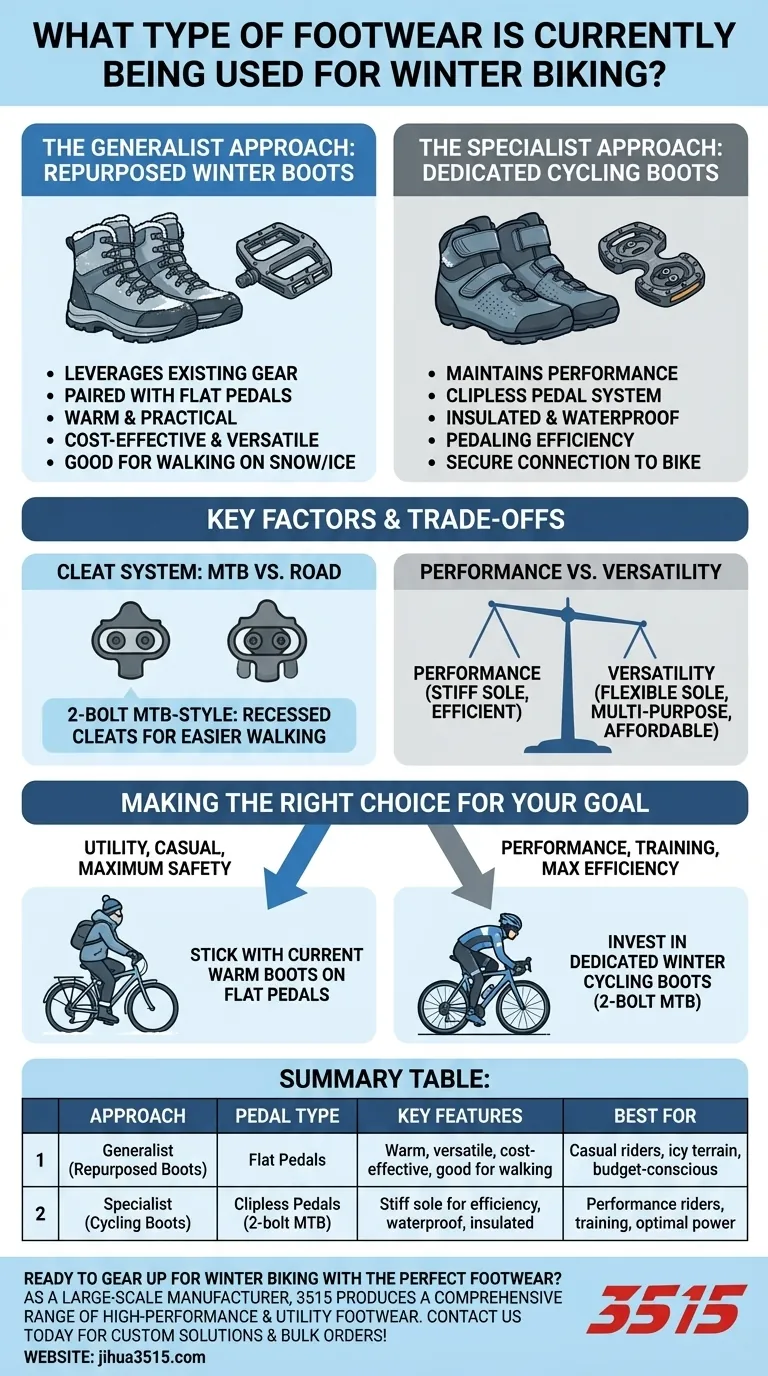The primary footwear options for winter biking fall into two categories: repurposed general winter boots used with flat pedals, or specialized, insulated cycling-specific boots designed for clipless pedal systems. Your current use of snow hiking boots is a common and effective solution, particularly for warmth and versatility.
The core decision in winter cycling footwear is a trade-off between the pedaling efficiency of cycling-specific boots and the versatility and lower cost of general-purpose winter boots. Understanding your primary riding goal—be it performance or casual utility—is the key to making the right choice.

The Two Core Approaches to Footwear
Your choice of footwear is fundamentally tied to your choice of pedals. This creates two distinct paths, each with its own advantages.
The Generalist Approach: Repurposed Winter Boots
This approach leverages existing or non-cycling-specific gear for warmth and practicality. It is always paired with flat pedals.
Your current snow hiking boots fall squarely into this category. Other popular options include insulated snowshoeing or even snowmobile boots.
The primary benefit here is cost-effectiveness and versatility. These boots are warm, waterproof, and allow you to easily walk through snow or on ice when you're off the bike.
The Specialist Approach: Dedicated Cycling Boots
This is for riders who want to maintain the performance of a clipless pedal system through the winter.
Brands like Shimano, Lake, and Northwave produce high-quality, insulated, and waterproof boots designed specifically for cycling.
The key advantage is pedaling efficiency. Being clipped into the pedal allows for better power transfer and a more secure connection to the bike, which is crucial for performance-oriented riding.
Key Factors in Dedicated Cycling Boots
If you are considering the specialist route, the most important technical detail is the cleat system.
The Cleat System: MTB vs. Road
Winter cycling boots are available for both major clipless systems: 2-bolt (MTB style) and 3-bolt (road style).
For winter conditions, the 2-bolt MTB-style system is highly recommended.
The cleats are recessed into the boot's tread, making it significantly easier and safer to walk in slippery conditions without damaging the cleat.
Understanding the Trade-offs
Neither approach is universally "better." The optimal choice depends on balancing performance, cost, and practicality.
Performance vs. Price
Dedicated cycling boots are a significant investment. You are paying for the integration of a stiff, performance-oriented sole with high-quality insulation and waterproofing.
General winter boots are far more affordable and can serve multiple purposes. However, their flexible soles result in a noticeable loss of pedaling efficiency compared to a stiff cycling shoe.
On-Bike Connection vs. Off-Bike Mobility
A clipless system provides a secure, "locked-in" feeling that many performance riders prefer. This ensures your foot never slips off the pedal in rough or wet conditions.
Using flat pedals with hiking boots offers instant "foot-down" capability, which can be a major confidence booster on icy surfaces. The aggressive tread on these boots also provides superior traction for walking.
Making the Right Choice for Your Goal
To select the best system, be clear about what you want to achieve with your winter riding.
- If your primary focus is utility, casual rides, or maximum safety on icy terrain: Stick with your current setup of warm hiking or snowshoeing boots on flat pedals.
- If your primary focus is performance, training, or achieving maximum pedaling efficiency: Invest in a pair of dedicated winter cycling boots with a 2-bolt MTB clipless system.
Ultimately, the best footwear is the one that allows you to ride safely, comfortably, and consistently through the cold.
Summary Table:
| Approach | Pedal Type | Key Features | Best For |
|---|---|---|---|
| Generalist (Repurposed Boots) | Flat Pedals | Warm, versatile, cost-effective, good for walking | Casual riders, icy terrain, budget-conscious users |
| Specialist (Cycling Boots) | Clipless Pedals (2-bolt MTB style recommended) | Stiff sole for efficiency, waterproof, insulated | Performance-oriented riders, training, optimal power transfer |
Ready to gear up for winter biking with the perfect footwear?
As a large-scale manufacturer, 3515 produces a comprehensive range of high-performance and utility footwear for distributors, brand owners, and bulk clients. Whether you need durable, insulated cycling boots for clipless systems or versatile winter boots for flat pedals, our production capabilities cover all types of shoes and boots to meet your specific needs.
Let us help you equip your customers with reliable, comfortable, and efficient winter biking footwear. Contact us today to discuss custom solutions and bulk orders!
Visual Guide

Related Products
- Safety Footwear Wholesale Manufacturer for Custom OEM/ODM Production
- Durable Waterproof Rain Boots | Custom Manufacturer for Wholesale & Brands
- Durable Rubber Sole Outdoor Shoes Wholesale & Custom Manufacturing
- Premium Insulated Safety Boots and Shoes for Wholesale & Bulk Orders
- Premium Suede Sport Safety Shoes for Wholesale & Bulk Orders
People Also Ask
- Is it normal to wear shoes in the house? A Guide to Hygiene, Comfort & Culture
- What cultural and environmental considerations are tied to wearing shoes indoors? Balance Hygiene, Tradition, and Foot Health
- What are the differences between steel toe, composite toe, and alloy toe Wellington boots? Choose the Right Safety Toe for Your Job
- Is safety-toe as good as steel toe? Choose the Right Protection for Your Job
- How long can you wear safety boots? The Lifespan is Determined by Wear, Not Time



















